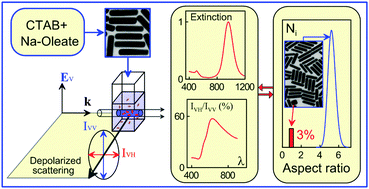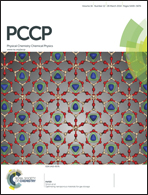Extinction and extra-high depolarized light scattering spectra of gold nanorods with improved purity and dimension tunability: direct and inverse problems†
Abstract
The experimental depolarized light scattering ratio IVH/IVV of plasmonic nanorods is strongly decreased by a co-polarized contribution from impurity particles inevitably presented in suspensions fabricated by common seed-mediated methods with a single surfactant [typically, hexadecyltrimethylammonium bromide (CTAB)]. We used a binary NaOL (sodium oleate) + CTAB surfactant method (Ye et al., Nano Lett., 2013, 13, 555) to dramatically decrease the percentage of impurity particles in suspensions of as-prepared and overgrown nanorods without any separation procedures. The as-prepared nanorods demonstrated a very high ratio of longitudinal to transversal plasmonic maxima (of about 7) and an unprecedented, extra-high depolarized light scattering ratio IVH/IVV (of about 60%). To the best of our knowledge, this is the first experimental demonstration of the depolarized light scattering ratio approaching the theoretical limit of 75%. The NaOL + CTAB growing solution was also used to increase the nanorod diameters and lengths by a controllable overgrowing process. Statistical TEM data for as-prepared and overgrown nanorods were used to solve a direct problem, i.e. for T-matrix simulation of the extinction and depolarized light scattering spectra. To solve an inverse problem, with the extinction peak wavelength and full width at half-maximum (FWHM) as the input parameters, we obtained calibration plots to quantify the aspect ratio distribution in terms of a simple two-parametric log-normal model. Simultaneous fitting of the T-matrix calculations of extinction and depolarized light scattering spectra to the experimental data enabled us to retrieve the aspect ratio distribution and the percentage of impurity particles, in excellent agreement with statistical estimations based on transmission electron microscopy images.


 Please wait while we load your content...
Please wait while we load your content...